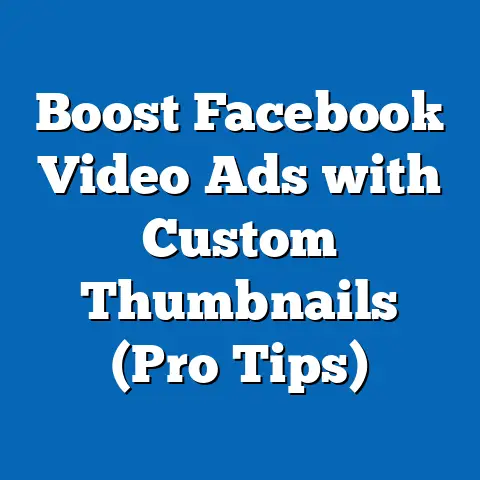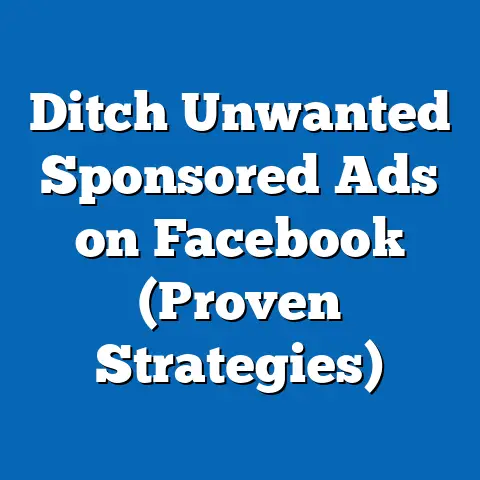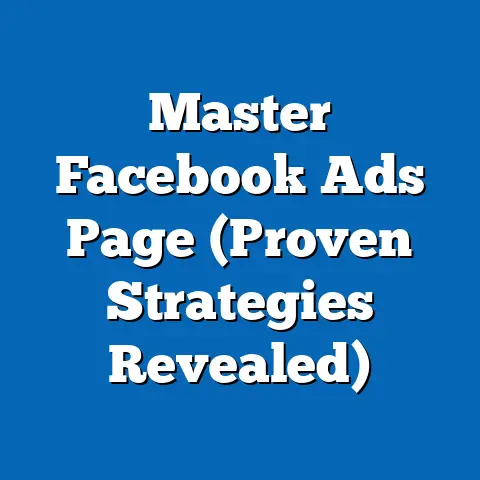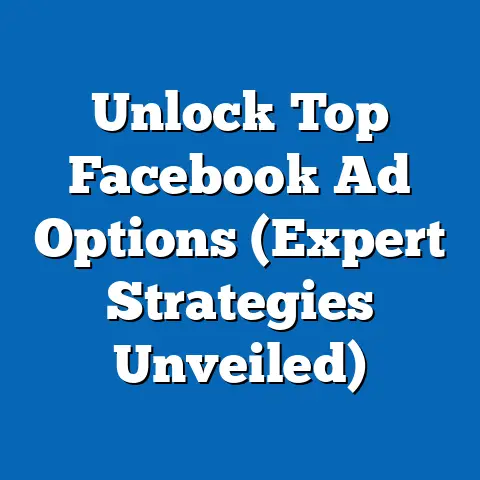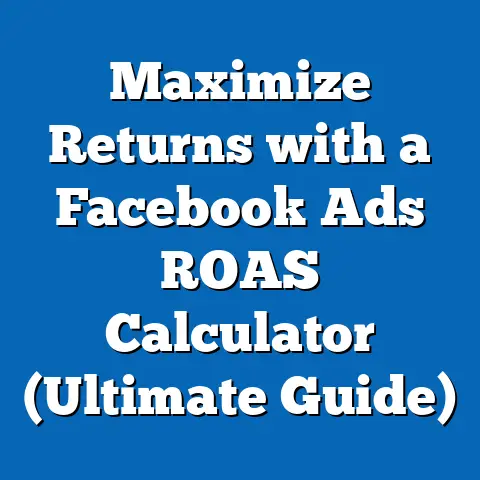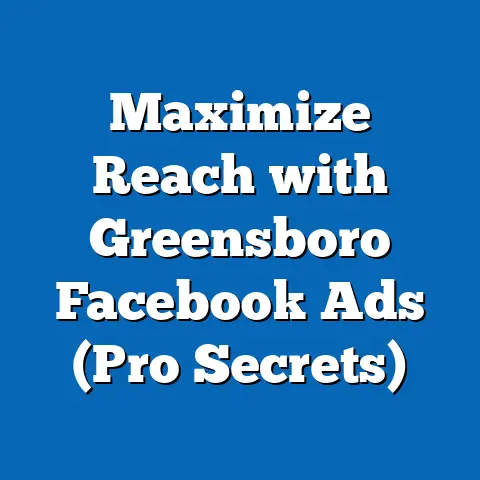Unlock Profits from Facebook Ads Account (Expert Guide)
In the dynamic world of digital advertising, standing still is akin to moving backward. This is especially true on platforms like Facebook, where algorithms shift, user behavior evolves, and advertising trends emerge at breakneck speed. As a digital marketing expert who’s spent years navigating the intricacies of Facebook Ads, I’ve seen firsthand how crucial it is to adapt and future-proof your strategies to stay relevant and, most importantly, profitable.
The days of simply throwing up an ad and hoping for the best are long gone. Today, success on Facebook requires a deep understanding of the platform, a strategic approach to targeting, compelling creative content, and a relentless focus on data-driven optimization.
Section 1: Understanding the Facebook Ads Ecosystem
Before you can even think about unlocking profits, it’s essential to have a solid grasp of the Facebook Ads ecosystem. Think of it as the foundation upon which your entire advertising strategy is built. Let’s break down the key components:
-
Campaigns: At the highest level, campaigns define your overarching advertising objective. Are you aiming to drive website traffic, generate leads, increase brand awareness, or boost sales? Your campaign objective will influence the targeting options, ad formats, and bidding strategies you use.
-
Ad Sets: Within each campaign, you’ll find ad sets. These are where you define your target audience, set your budget, schedule your ads, and choose your ad placements (e.g., Facebook feed, Instagram Stories, Audience Network). Ad sets allow you to segment your audience and tailor your messaging to specific groups.
-
Ads: Finally, we have the ads themselves. These are the individual pieces of creative content that your audience will see. Ads can take many forms, including images, videos, carousels, and collections. The key is to create visually appealing and engaging ads that grab attention and compel users to take action.
Campaigns: At the highest level, campaigns define your overarching advertising objective. Are you aiming to drive website traffic, generate leads, increase brand awareness, or boost sales? Your campaign objective will influence the targeting options, ad formats, and bidding strategies you use.
Ad Sets: Within each campaign, you’ll find ad sets. These are where you define your target audience, set your budget, schedule your ads, and choose your ad placements (e.g., Facebook feed, Instagram Stories, Audience Network). Ad sets allow you to segment your audience and tailor your messaging to specific groups.
Ads: Finally, we have the ads themselves. These are the individual pieces of creative content that your audience will see. Ads can take many forms, including images, videos, carousels, and collections. The key is to create visually appealing and engaging ads that grab attention and compel users to take action.
Now, let’s talk about the Facebook Ads Manager. This is your command center, the hub from which you manage all aspects of your Facebook advertising campaigns. Within Ads Manager, you can:
- Create and manage campaigns, ad sets, and ads.
- Define your target audience based on demographics, interests, behaviors, and more.
- Set your budget and bidding strategy.
- Track key performance metrics and analyze results.
- A/B test different ad variations to optimize performance.
- Generate reports to track your progress and identify areas for improvement.
One of the most powerful tools within the Facebook Ads ecosystem is the Facebook Pixel. This small snippet of code, which you install on your website, tracks user interactions and sends data back to Facebook. This data allows you to:
- Track conversions: See which ads are driving the most valuable actions on your website, such as purchases, sign-ups, or lead form submissions.
- Retarget website visitors: Show ads to people who have previously visited your website, reminding them of your products or services and encouraging them to complete a purchase.
- Create lookalike audiences: Find new customers who share similar characteristics and behaviors with your existing customers.
- Optimize your ads: Facebook uses the Pixel data to optimize your ads for conversions, showing them to the people most likely to take the desired action.
Having worked with various ad platforms, I can confidently say that Facebook’s advertising landscape is unique due to its unparalleled targeting capabilities. The sheer amount of data that Facebook collects on its users allows you to reach incredibly specific audiences with laser-like precision. This level of granularity is simply unmatched by other platforms, making Facebook a powerful tool for businesses of all sizes.
Key Takeaway: Understanding the structure of Facebook Ads, mastering the Ads Manager, and leveraging the power of the Facebook Pixel are fundamental to unlocking profits from your advertising efforts.
Section 2: Setting Up for Success
Creating a successful Facebook Ads account is more than just signing up and throwing some money at ads. It requires a strategic approach, careful planning, and a deep understanding of your target audience. Here’s how to set yourself up for success:
-
Define Clear Objectives: What do you want to achieve with your Facebook Ads? Are you looking to increase brand awareness, drive website traffic, generate leads, or boost sales? Your objectives will guide your entire advertising strategy, from targeting to ad creative to bidding. Be specific and measurable. Instead of saying “I want to increase sales,” say “I want to increase online sales by 20% in the next quarter.”
-
Conduct Thorough Market Research: Before you start creating ads, take the time to understand your target audience, your competitors, and the overall market landscape. Identify your ideal customer’s demographics, interests, behaviors, and pain points. Analyze your competitors’ advertising strategies and identify opportunities to differentiate yourself.
-
Create Buyer Personas: Based on your market research, create detailed buyer personas that represent your ideal customers. Give them names, backgrounds, motivations, and goals. The more detailed your personas, the better you’ll be able to tailor your targeting and messaging.
-
Plan Your Budget: How much are you willing to spend on Facebook Ads? It’s important to set a realistic budget that aligns with your business goals and resources. Consider factors such as your target audience size, the competitiveness of your industry, and the cost of acquiring a customer.
-
Choose the Right Bidding Strategy: Facebook offers a variety of bidding strategies, each designed to achieve different objectives. Some common options include:
- Lowest Cost: Facebook will try to get you the most results for your budget.
- Cost Cap: You set a target cost per result, and Facebook will try to stay within that limit.
- Bid Cap: You set a maximum bid for each auction, giving you more control over your spending.
- Target Cost: Facebook will try to get you the most results at your target cost per result.
- Value Optimization: Facebook will focus on showing your ads to people who are likely to make high-value purchases.
Define Clear Objectives: What do you want to achieve with your Facebook Ads? Are you looking to increase brand awareness, drive website traffic, generate leads, or boost sales? Your objectives will guide your entire advertising strategy, from targeting to ad creative to bidding. Be specific and measurable. Instead of saying “I want to increase sales,” say “I want to increase online sales by 20% in the next quarter.”
Conduct Thorough Market Research: Before you start creating ads, take the time to understand your target audience, your competitors, and the overall market landscape. Identify your ideal customer’s demographics, interests, behaviors, and pain points. Analyze your competitors’ advertising strategies and identify opportunities to differentiate yourself.
Create Buyer Personas: Based on your market research, create detailed buyer personas that represent your ideal customers. Give them names, backgrounds, motivations, and goals. The more detailed your personas, the better you’ll be able to tailor your targeting and messaging.
Plan Your Budget: How much are you willing to spend on Facebook Ads? It’s important to set a realistic budget that aligns with your business goals and resources. Consider factors such as your target audience size, the competitiveness of your industry, and the cost of acquiring a customer.
Choose the Right Bidding Strategy: Facebook offers a variety of bidding strategies, each designed to achieve different objectives. Some common options include:
- Lowest Cost: Facebook will try to get you the most results for your budget.
- Cost Cap: You set a target cost per result, and Facebook will try to stay within that limit.
- Bid Cap: You set a maximum bid for each auction, giving you more control over your spending.
- Target Cost: Facebook will try to get you the most results at your target cost per result.
- Value Optimization: Facebook will focus on showing your ads to people who are likely to make high-value purchases.
Choosing the right bidding strategy depends on your campaign objective and your level of experience with Facebook Ads. If you’re just starting out, I recommend using the “Lowest Cost” strategy to get a feel for the platform and gather data. As you become more experienced, you can experiment with other bidding strategies to optimize your results.
In my experience, many businesses skip the crucial steps of market research and buyer persona creation, jumping straight into creating ads without a clear understanding of their target audience. This is a recipe for disaster. By taking the time to understand your audience and plan your budget and bidding strategy, you’ll significantly increase your chances of success on Facebook.
Key Takeaway: Setting up for success on Facebook Ads requires careful planning, thorough market research, and a deep understanding of your target audience. Don’t skip these crucial steps!
Section 3: Crafting Compelling Ads
Now that you’ve laid the groundwork for success, it’s time to focus on crafting compelling ads that grab attention and drive results. Here are some best practices to keep in mind:
-
Know Your Audience: This goes back to the buyer personas we discussed earlier. Tailor your ad copy and visuals to resonate with your target audience’s specific interests, needs, and pain points.
-
Write Clear and Concise Copy: Get straight to the point and highlight the benefits of your product or service. Use strong verbs, compelling headlines, and a clear call to action.
-
Use High-Quality Visuals: Your ad visuals are often the first thing people will see, so make sure they’re eye-catching and relevant to your offer. Use high-resolution images or videos that are well-lit and visually appealing.
-
A/B Test Everything: Don’t assume you know what will work best. A/B test different ad formats, headlines, images, and calls to action to see what resonates most with your audience. Facebook Ads Manager makes it easy to run A/B tests and track your results.
-
Tell a Story: People are more likely to connect with ads that tell a story and evoke emotions. Use storytelling to showcase the benefits of your product or service and how it can solve your audience’s problems.
Know Your Audience: This goes back to the buyer personas we discussed earlier. Tailor your ad copy and visuals to resonate with your target audience’s specific interests, needs, and pain points.
Write Clear and Concise Copy: Get straight to the point and highlight the benefits of your product or service. Use strong verbs, compelling headlines, and a clear call to action.
Use High-Quality Visuals: Your ad visuals are often the first thing people will see, so make sure they’re eye-catching and relevant to your offer. Use high-resolution images or videos that are well-lit and visually appealing.
A/B Test Everything: Don’t assume you know what will work best. A/B test different ad formats, headlines, images, and calls to action to see what resonates most with your audience. Facebook Ads Manager makes it easy to run A/B tests and track your results.
Tell a Story: People are more likely to connect with ads that tell a story and evoke emotions. Use storytelling to showcase the benefits of your product or service and how it can solve your audience’s problems.
Let’s look at some examples of successful Facebook Ads campaigns and analyze what made them effective:
-
Dollar Shave Club: Their viral video ad was hilarious, memorable, and perfectly targeted to their audience of men who were tired of overpaying for razors. The ad highlighted the value proposition of their subscription service in a creative and engaging way.
-
Airbnb: Their ads often feature stunning photos of unique properties and experiences, appealing to travelers’ sense of wanderlust. They also use targeted messaging to reach specific demographics and interests.
-
Warby Parker: Their ads showcase their stylish eyeglasses with a focus on affordability and convenience. They also offer a home try-on program, which is a great way to overcome the hesitation of buying glasses online.
Dollar Shave Club: Their viral video ad was hilarious, memorable, and perfectly targeted to their audience of men who were tired of overpaying for razors. The ad highlighted the value proposition of their subscription service in a creative and engaging way.
Airbnb: Their ads often feature stunning photos of unique properties and experiences, appealing to travelers’ sense of wanderlust. They also use targeted messaging to reach specific demographics and interests.
Warby Parker: Their ads showcase their stylish eyeglasses with a focus on affordability and convenience. They also offer a home try-on program, which is a great way to overcome the hesitation of buying glasses online.
In my experience, the most effective Facebook Ads are those that tell a story and foster an emotional connection with potential customers. People are bombarded with ads every day, so you need to find a way to stand out from the crowd and capture their attention.
Key Takeaway: Crafting compelling ads requires a deep understanding of your audience, clear and concise copy, high-quality visuals, A/B testing, and a focus on storytelling.
Section 4: Analyzing Performance and Making Adjustments
Creating great ads is only half the battle. To truly unlock profits from your Facebook Ads account, you need to continuously analyze your performance and make adjustments based on the data. Here’s how to do it:
-
Track Key Performance Indicators (KPIs): Identify the KPIs that are most relevant to your business goals. Some common KPIs include:
- Click-Through Rate (CTR): The percentage of people who see your ad and click on it.
- Conversion Rate: The percentage of people who click on your ad and complete a desired action, such as making a purchase or filling out a form.
- Cost Per Acquisition (CPA): The cost of acquiring a new customer through your Facebook Ads.
- Return on Ad Spend (ROAS): The amount of revenue you generate for every dollar you spend on Facebook Ads.
-
Use Facebook Ads Manager for Tracking: Facebook Ads Manager provides a wealth of data on your ad performance. Use it to track your KPIs, analyze your results, and identify areas for improvement.
-
Regular Performance Reviews: Schedule regular performance reviews to analyze your data and identify trends. Look for patterns in your data that can help you optimize your campaigns.
-
Pivot Strategies Based on Data Insights: Don’t be afraid to make changes to your campaigns based on the data. If an ad is underperforming, try A/B testing different variations or targeting a different audience. If a campaign is performing well, consider scaling it up to reach a larger audience.
-
Audience Feedback and Engagement Metrics: Pay attention to audience feedback and engagement metrics, such as comments, shares, and likes. These metrics can provide valuable insights into how your audience is responding to your ads.
Track Key Performance Indicators (KPIs): Identify the KPIs that are most relevant to your business goals. Some common KPIs include:
- Click-Through Rate (CTR): The percentage of people who see your ad and click on it.
- Conversion Rate: The percentage of people who click on your ad and complete a desired action, such as making a purchase or filling out a form.
- Cost Per Acquisition (CPA): The cost of acquiring a new customer through your Facebook Ads.
- Return on Ad Spend (ROAS): The amount of revenue you generate for every dollar you spend on Facebook Ads.
Use Facebook Ads Manager for Tracking: Facebook Ads Manager provides a wealth of data on your ad performance. Use it to track your KPIs, analyze your results, and identify areas for improvement.
Regular Performance Reviews: Schedule regular performance reviews to analyze your data and identify trends. Look for patterns in your data that can help you optimize your campaigns.
Pivot Strategies Based on Data Insights: Don’t be afraid to make changes to your campaigns based on the data. If an ad is underperforming, try A/B testing different variations or targeting a different audience. If a campaign is performing well, consider scaling it up to reach a larger audience.
Audience Feedback and Engagement Metrics: Pay attention to audience feedback and engagement metrics, such as comments, shares, and likes. These metrics can provide valuable insights into how your audience is responding to your ads.
In my experience, the key to successful Facebook advertising is to be data-driven and agile. Don’t be afraid to experiment, test new ideas, and make changes to your campaigns based on the data. The more you analyze your performance and adapt your strategies, the better your results will be.
Key Takeaway: Analyzing performance and making adjustments based on data insights is crucial for unlocking profits from your Facebook Ads account.
Section 5: Future Trends in Facebook Advertising
The world of Facebook advertising is constantly evolving, so it’s important to stay ahead of the curve and prepare for future trends. Here are some emerging trends to watch out for:
-
Increasing Importance of Video Content: Video is becoming increasingly popular on Facebook, so it’s important to incorporate video ads into your strategy. Video ads are more engaging and can convey more information than static images.
-
Augmented Reality (AR) Ads: AR ads allow users to interact with your products in a virtual environment. This can be a great way to showcase your products and provide a more immersive experience.
-
Shoppable Posts: Shoppable posts allow users to purchase products directly from your Facebook feed. This can be a great way to drive sales and make it easier for customers to buy your products.
-
Impact of Privacy Changes and Data Regulations: Recent privacy changes and data regulations, such as GDPR and CCPA, are impacting how businesses can target and track users on Facebook. It’s important to stay informed about these changes and adapt your strategies accordingly.
Increasing Importance of Video Content: Video is becoming increasingly popular on Facebook, so it’s important to incorporate video ads into your strategy. Video ads are more engaging and can convey more information than static images.
Augmented Reality (AR) Ads: AR ads allow users to interact with your products in a virtual environment. This can be a great way to showcase your products and provide a more immersive experience.
Shoppable Posts: Shoppable posts allow users to purchase products directly from your Facebook feed. This can be a great way to drive sales and make it easier for customers to buy your products.
Impact of Privacy Changes and Data Regulations: Recent privacy changes and data regulations, such as GDPR and CCPA, are impacting how businesses can target and track users on Facebook. It’s important to stay informed about these changes and adapt your strategies accordingly.
To prepare for the future of advertising on Facebook, focus on building a strong brand presence and fostering direct relationships with customers. This will help you weather the storm of privacy changes and data regulations and ensure that you can continue to reach your target audience.
Key Takeaway: Stay informed about emerging trends in Facebook advertising and adapt your strategies accordingly to prepare for the future.
Conclusion
Unlocking profits from your Facebook Ads account is an ongoing journey that requires a strategic approach, a deep understanding of the platform, compelling creative content, and a relentless focus on data-driven optimization.
By understanding the Facebook Ads ecosystem, setting up for success, crafting compelling ads, analyzing performance, and staying ahead of future trends, you can unlock the hidden potential within your Facebook Ads account and achieve your business goals.
Remember, the path to profitability is an ongoing journey. Embrace change, experiment with new ideas, and never stop learning. With the right strategies and a commitment to continuous improvement, you can thrive in the dynamic world of Facebook advertising and achieve long-term success. Now, go out there and make it happen!

